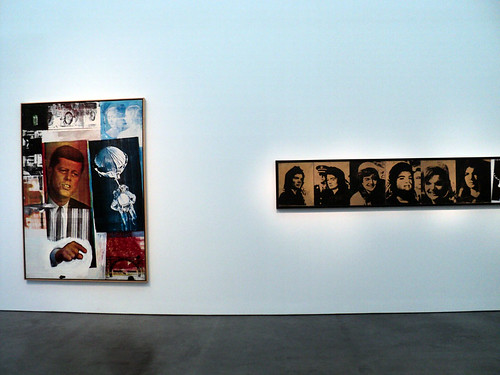I've tried to get publicity for my open studios everywhere I can, but never took the time to explain on this blog what, exactly, an open studio is.
The difference between an art gallery and an art studio
First, I will explain the difference between a gallery and an art studio. An art gallery is a place where art is displayed. It could be a museum, an artist-run space, or a commercial space, but in the end, its function is the same. It is a place where the public can come to view work by artists. Often sparsely furnished, a gallery's primary purpose is to showcase art. Some galleries can also be rented out for private events, but if they are commercial spaces, they are essentially stores whose merchandise is art.
 |
| One of the galleries of the Museum of Contemporary Art in Chicago. |
An art studio is a place where an artist makes art. Because it is a work space, and because of the nature of art supplies, it can get pretty messy. Depending on the medium an artist works in, a studio could be full of pens, pencils, stencils, paper, inks, pastels, paints, glue, cameras, tripods, easels, encaustic wax, markers, rulers, t-squares, clay, wood, sawdust, glass rods, blow torches, beads, feathers, leather, soldering irons, welding equipment, kilns, fabric, yarn, dye, sewing machines, looms, or found objects for making art, not to mention the various objects the artist uses as a source of inspiration. These items could range from books, flowers, leaves, mysterious keys, mannequins, cans, jars, bottles, old toys, industrial equipment, rusted farm machinery, fruits and vegetables, newspaper and magazine clippings, postcards of work by other artists, stickers, and fabric scraps, to a television or a laptop with a good Internet connection, and some sort of device that plays music. On occasion you may even find nude models or the artist's pets there. And that's not even factoring in early drafts of works in progress. Considering how messy and personal such a work space can get, most of the time, when the public goes to see art, they go to a gallery and not a studio.
 |
| My art studio when I first moved in. Without an easel, I had to paint on the floor. |
I mention this distinction because when I invite people to my open studio events, sometimes they think I have my own gallery. But I don't. I don't want to run a gallery; I just want to find one that will represent me. I'm happy just having an art studio. And my studio is definitely not a gallery.
So what is an open studio?
An open studio is a public art show at an artist's studio. Think of it as a factory tour or a behind-the-scenes view of how a movie was made. You can see art that the artist is still working on. Depending on what sort of arrangement the artist has with his or her gallery (if they are represented), you may be able to buy work from the artist at the open studio. And it that aspect, it can be a little like buying direct at the factory store. Like an art opening, an open studio is a hospitable event, and there are usually light refreshments free of charge for guests. In buildings or neighborhoods where there are multiple artists' studios, it's common to hold several open studios simultaneously as part of one big event. That's what we do on the second Friday of each month at the Fine Arts Building.
Pictures from my previous open studios.
Why should I attend an open studio?
If you want to see art in the place where it was created, you should attend an open studio. Because it is more intimate than a big, fancy gallery opening, it can feel less intimidating. You have a much better chance of being able to speak to the artists one on one, and maybe even meet their close friends and family members. If you're a creative person yourself, attending an open studio can be very inspiring. Before I got a studio of my own, I was fascinated with the various ways in which other artists set up their work spaces. If you're drained from working all day and you go to an open studio after work or on your day off, you might find the experience energizing. It can be a fun event to attend with friends or with a date. Most open studios are free of charge (though some ask for a small donation) so they make an inexpensive group activity. And of course, if you're a collector and want to get your hands on some new art that none of your friends or neighbors have, an open studio is the ideal setting to buy art.
Who should attend an open studio?
As you can see from the previous paragraph, open studios can appeal to people for a wide variety of reasons. They're for everyone who likes art, no matter what their age. I make it a point to say that kids are welcome at my open studios, as long as they are well behaved. And by that, I mean as long as they don't steal, break things, climb the walls, or try to eat whatever they can get their hands on, even if it is inedible.
 |
| If your baby insists on putting everything in his mouth, please don't bring him to my studio. |
Remember my crazy list of all the odds and ends that you may find in a studio, the sharp objects and various chemicals? An art studio is not designed to be a child-proof space, so use common sense. And in my case, even though the materials I use are non-toxic, it doesn't mean that they are edible. I love kids, and don't want them to get hurt. As for my subject matter, my paintings are abstract and family-friendly, though The Doll Project could spark some serious discussions about the media and body image. Obviously there is plenty of art out there that deals with subjects that may not be age appropriate, so try to look at the artist's website first before you bring children to their studio.
Now that I've gotten those warnings out of the way, I can talk about the benefits of taking children to an open studio. It can be a very educational experience for them, whether they are just learning their colors and shapes, or are older kids who enjoy art classes at school. It gives them a chance to see a unique workspace while interacting with living artists, as opposed to seeing art at a museum. So if you don't have a babysitter and your kids know how to conduct themselves amongst grown-ups, bring them along.
Hopefully this post has cleared up any confusion you may have had about art galleries and art studios and you'll visit my studio sometime.

No comments:
Post a Comment